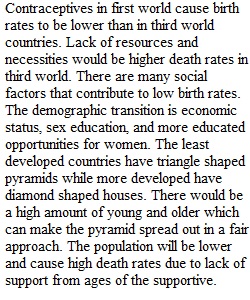


Q Getting Started Previously, in Workshop 2 you had the opportunity to read and begin discussion about the human population, population growth, and global impact of an increasing human population. In this lab you will further investigate the concept of demography and the impact of birth and death rates on demographic transitions- the transition to low birth and death rates. You will make predictions regarding population growth of various countries, make comparisons between countries, and theorize on the cause and effect of a country’s population growth. Upon successful completion of this assignment, you will be able to: • Make scientific predictions, analyze scientific data and theorize how the information can be applied. ________________________________________ Resources • Textbook: Essential Environment: The Science Behind the Stories • Website: The Habitable Planet: A Systems Approach to Environmental Science, Interactive Labs • File: WS3 Lab Demographics • Video: WS3 Lab Tutorial. ________________________________________ Instructions 1. Review the rubric to make sure you understand the criteria for earning your grade. 2. Read Chapter 6 in Essential Environment: The Science Behind the Stories 3. Watch WS3 Lab Tutorial. 4. Download the WS3 Lab_Demographics file. 5. Navigate to The Habitable Planet, Demographics Lab a. Read and complete the lab lessons The Demographic Transition and Social Impact b. Record data and answer questions in the WS3 Lab_Demographics document (do not download the data table from the interactive lab) 6. The writing must follow APA requirements. 7. When you have completed your assignment, save a copy of your completed lab document for yourself and submit a copy to your instructor using the Assignment submission page by the end of the workshop. ________________________________________ Access the associated rubric Access the Assignment submission page Workshop 3: Demographics Lab Courtney Murray 9/19/2022 Navigate to the websitehttps://www.learner.org/courses/envsci/interactives/demographics/. Complete the lab lessons entitled “The Demographic Transition” and “Social Impacts”. Record your data in the tables below and answer the analysis questions that follow each step. Lesson 1: The Demographic Transition Read the lab Overview and The Demographic Transition: Step 1. Click on Open Simulator. Select a country from the drop-down menu at the top of the simulator. Record the birth rate, death rate, and population growth percentage as found in the 2015 Vital Rates box. Click on Run to simulate the population transition until 2050. Record the 2050 growth rate percentage. Record this information for each of the 9 countries listed below. In the last column, rank the countries from highest growth rate (1) to lowest growth rate (9) based on the population growth in 2050. Lesson 1: The Demographic Transition Step 1 Country Birth Rate Death Rate Population Growth 2015(%) Population Growth 2050 (%) Relative ranking transition USA 1.98 1.16 0.78% -0.15% Nigeria Brazil 1.72 per women 0.86% per yr 0.86% per yr -.026 % yr Iraq China 1.52 1.05 0.47 -0.98 Italy India 2.26 0.99 1.34 0.46 Japan Indonesia 2.07 0.95 1.03 0.21 China Iraq 3.15 0.63 2.45 1.72 India Italy 1.41 1.34 0.36 -1.17 Brazil Japan 1.39 1.40 -0.10 -1.15 Indonesia Nigeria 4.07 1.11 2.65 2.84 USA Step 1 Analysis Questions: answer the following using complete sentences. How do you suppose living conditions differ between the country furthest along in the demographic transition (lowest growth rate) compared to the country earliest in the transition (highest growth rate)? How would living conditions in these two countries affect both birth and death rates?
View Related Questions